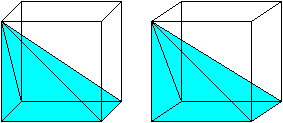Why is the volume of a cone one third of the volume of a cylinder?

A visual demonstration for the case of a pyramid with a square base. As Grigory states, Cavalieri's principle can be used to get the formula for the volume of a cone. We just need the base of the square pyramid to have side length $ r\sqrt\pi$. Such a pyramid has volume $\frac13 \cdot h \cdot \pi \cdot r^2. $

Then the area of the base is clearly the same. The cross-sectional area at distance a from the peak is a simple matter of similar triangles: The radius of the cone's cross section will be $a/h \times r$. The side length of the square pyramid's cross section will be $\frac ah \cdot r\sqrt\pi.$
Once again, we see that the areas must be equal. So by Cavalieri's principle, the cone and square pyramid must have the same volume:$ \frac13\cdot h \cdot \pi \cdot r^2$
One can cut a cube into 3 pyramids with square bases -- so for such pyramids the volume is indeed 1/3 hS. And then one uses Cavalieri's principle to prove that the volume of any cone is 1/3 hS.
I just did a demonstration with my class that took about 2 minutes. Granted it was just inductive reasoning but it satisfied the students for now. I had 2 pairs of students come up to the front of the class. One pair had a cone and a cylinder. One pair had a pyramid and a prism. Each pair had solids with a congruent base and height. The person with the cone had to see how many times they could fill the cone with water and fit it into the cylinder. Similarly the person with the pyramid had to see how many times they could fill the pyramid with water and fit it into the prism. Other than ensuring that the cone and the pyrmaid were not overfilled (taking into consideration that the water has a curved skin at the top) the experiment was simple and the demonstration made it easier for the students to remember the relationship. Hope this helps.